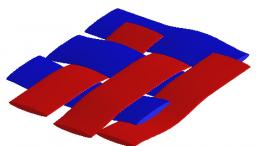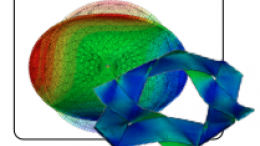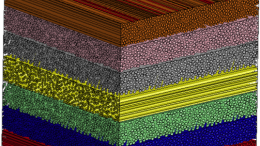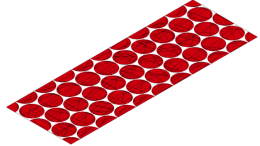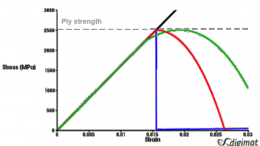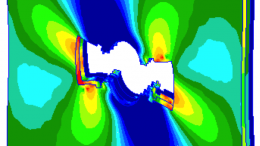
Digimat simulation software for composite materials
With promises of great performance, composite materials and structures also present many challenges to engineers. Composites are tuned to exhibit outstanding performance in their material properties depending on the material mixture and properties of the microstructure, which are vastly influenced by processing conditions. These processing conditions tweak the composite properties and it is thus essential to include processing in the performance description of the final design.
Your modeling software for the predictive design of composite materials:
Predictive simulations are key to the development of composite materials, as well as their application in structural design. Furthermore, shifting from a metal to composite paradigm requires a dedicated tool for composite design in order to take into account the specific composite behavior. This behavior can vary widely over the entire part mainly due to the process. Classical design tools are not able to describe accurately the local composite material behavior, leading to the introduction of large safety factors and lack of confidence in the design.
Benefits of using Digimat modeling software for composite materials:
Digimat is an enabling technology that provides design tools that give the user 100% confidence in their composite products, thanks to an advanced and accurate description of the local composite behavior. As unnecessary security factors can be left aside thanks to Digimat, composite materials are used to 100% of their potential, maximizing their competitiveness against metal and leading to substantial weight reduction. Digimat tools integrate smoothly within the current FEA process, bridging the gap between manufacturing process and structural analysis.
|
DFC (Discontinuous Fiber Composites) consist of chopped UD (unidirectional composite) slices, called chips or strands. DFC may contain up to 100% of strands. This kind of composites is used in the industries more and more - especially for high performance structures, e.g. aircrafts, high performance cars, technical sports and leisure equipments. The increased interest in this material is mainly due to its adaptability to complex geometries for which conventional composite materials are not suitable. Furthermore, it offers high production throughput by comparison to more conventional composites. On the other hand, because of the relative important size of the constitutive strands in comparison with the material dimensions, DFC presents a high mechanical behavior variability. Consequently, the use of a numerical tool for the evaluation of its properties may avoid long and expensive experimental campaigns. In this framework, Digimat offers a strategic tool for modeling such materials. Digimat solution for modeling DFC is based on the voxelization technology. Digimat evaluates the material response by means of full field homogenization based on the finite element method. It allows reaching up to 100% of volume fraction of strands as well as adding additional phases (resin rich areas, voids, other phases...). The mesh generation is fast and robust. The proposed solution makes it possible to evaluate the variability of the mechanical behavior of the microstructure. Furthermore, it offers the evaluation of the influence of microstructural properties (mean orientation tensor of the strands, properties of the constitutive phases, size of the strands...) on its macroscopic behavior. Digimat offers a real added value for the DFC users since it makes the link between its different scales. It allows consequently a better comprehension of its behavior and an optimized use of it. |
|
Unidirectional composites (UD) offer a large playground to tune optimal material properties. Thermoset and thermoplastic matrices are reinforced with different types of fibers: glass, carbon, aramid, etc. UD fibers are straight and non-crimped. In the laminate, they are laid up in specific stacking sequences, varying the fiber volume fraction, the thickness and orientation of plies. This results in the highest possible in-plane [UD perform bad under impact!] laminate properties in the final composite component construction. It is the general design principle for UD composites to use material properties in an optimal way. The high level of individuality in using UD composites offers great chances in designing high performance structural parts. However, the drawback of these materials can be that manufacturing is slow and expensive which impacts on the design process. For this reason, the virtual design of UD composites plays an increasingly important role in time and cost efficient development strategies. Digimat offers a full set of capabilities for the design of UD composite materials and structures. This starts by choosing the right material mixture for the intended application from virtual property screening on the material and coupon level. Key to success is the progressive failure model which allows to take into account the anisotropic damage of the UD material. Digimat also offers capabilities to build integrative simulations based on draping analyses, relying on local fiber orientations as they result in the part due to the influence of the manufacturing process. |
|
Woven composites are typically draped onto more or less complex surfaces to produce structural parts. The draping process can have significant impact on local warp and weft angles which leads to a local variation of effective material properties. Understanding the connection between the warp / weft microstructure, the resulting material properties and finally their influence on the part performance is crucial knowledge in the design process of woven composite structure. Digimat offers strong capabilities for the design of woven composite materials and structures. This starts with tools for material investigations based on an advanced woven model that is capable to consider the underlying weave pattern and yarn structure. These capabilities cover the 2D as well as the 2.5D weave patterns in which the warp yarns go across multiple layers of weft yarns, hence improving the interlaminar toughness and the impact resistance of the material. Structural analyses can be set up based on local warp / weft information from draping simulations. Material modeling can be performed fully nonlinear, temperature and strain rate dependent. Failure is derived from the microscopic responses in the material resulting in a realistic description of the experimentally observed strengths. The large amount of woven designs is still found where tailor made, high-end solutions are needed and a costly solution is acceptable. The applications cover the Aerospace, Automotive (racing), Marine, wind technology and sport equipment markets. The overall objective is to use light-weight materials with the best stiffness and strength properties possible. Digimat is a strategic tool in this context as it reflects the real world strategies completely by mixing the material from its microscopic components and determining the performance of the woven composite on the material and on the part levels. |
|
To the contrary of woven fabrics in which the yarns cross at 90°, in braided composites, yarns can cross at an angle ranging between 30° and 150° which can evolve continuously across the part. This gives more design capabilities. With braided composites, the reinforcement does not need to be cut to shape from a roll and laid down onto the mold. It is directly braided around a mandrel which has the shape of the part to be made. This speeds up the manufacturing process but requires a dedicated equipment. This process further makes it possible to produce more complex parts which, however, are limited to convex shapes and hollow profiles. In advanced braided reinforcements, multiple layers can be added on top of each other, yarns can also go across multiple layers, as with 2.5 D woven composites, and extra yarns, called inlays, can be added in the direction parallel to the axis of the braiding axis. Digimat offers strong capabilities for the design of braided composite materials and structures. This starts with tools for material investigations based on advanced models which are capable of considering the underlying yarn structure and braiding pattern (including yarns going across multiple layers and inlays). Just as for the woven composites, material modeling can be performed fully nonlinear, temperature and strain rate dependent. Failure is derived from the microscopic responses in the material resulting in a realistic description of the experimentally observed strengths. All these capabilities nicely complement those in UD and woven reinforcements. They give the user the possibility to take into consideration many different reinforcement options and, hence, to design even more competitive products. |

